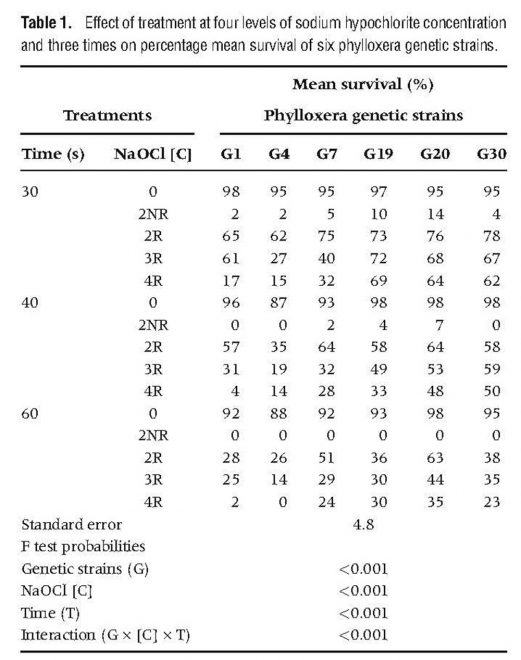Recent studies have shown that a 60 second treatment is required to demonstrate 100% mortality across six key strains of phylloxera. Dr Kevin Powell reports.
Grape phylloxera usually spreads from vineyard to vineyard via human pathways, including footwear, clothing, grape-picking bins, machinery and equipment, soil, grapes, grape foliage and planting material (Deretic et al. 2003). First instar nymphs are the most dispersive stage, usually involved in infestations.
Management of phylloxera in Australia is predominantly through quarantine procedures involving thorough disinfestation and cleaning of all items that come into contact with infested vineyards to minimise the risk of spread to non-infested vineyards.
However, the current National Phylloxera Management Protocol (NPMP) was written prior to our understanding of strains in Australia. It’s now known that in Australia, there are 83 phylloxera genetic strains.
It’s important to consider the differences in susceptibility of these phylloxera strains to disinfestation treatments in our NPMP with protocols designed to ensure 100% mortality of all phylloxera strains.
- Studies undertaken by Clarke et al. (2017) have resulted in changes to our disinfestation protocol for footwear and small hand tools as previously advised by Vinehealth Australia.
- This work used the NPMP disinfestation recommendation of 2% sodium hypochlorite for 30 seconds followed by water rinse as the ‘control’ to investigate the survival of first instars of six phylloxera strains, G1, G4, G7, G19, G20 and G30, following immersion in four concentrations (0%, 2%, 3%, 4%) of sodium hypochlorite for 30, 40 and 60 seconds. Objectives were to:
(i) Identify the optimal sodium hypochlorite concentration and duration required to achieve 100% first instar mortality for all six genetic phylloxera strains; and
(ii) Establish the interaction between first instar survival and a water rinse treatment following sodium hypochlorite (NaOCl) treatments.
- This work found (refer to Table 1 sourced from Clarke et al. (2017)):
- Differences in strain susceptibility to disinfestation treatments;
- Minimal mortality in water for all three time periods;
- As sodium hypochlorite concentration was increased in conjunction with a rinse (R), almost all strains still survived irrespective of the sodium hypochlorite concentration;
- ‘No rinse’ treatments showed significantly higher mortality rates across all phylloxera strains, irrespective of the length of the treatment;
- At a 2% strength sodium hypochlorite with no rinse, a 60 second treatment was required to demonstrate 100% mortality across all strains. This was not achieved when treatment duration was either 30 or 40 seconds in length.
These findings underline the importance of carrying out footwear and small hand tool disinfestation at the correct concentration and duration, without a rinse thereafter, to ensure the effectiveness of the treatment.
Work continues in the search for effective alternatives to sodium hypochlorite.
For the current footwear and small hand tool protocol on which this work was based click here: https://vinehealth.com.au/media/Vinehealth-Footwear-and-Small-Hand-Tools-Disinfestation-Protocol-White-A3.pdf
References
- Clarke, C. W., Wigg, F., Norng, S., and Powell, K. S. (2017). Effectiveness of sodium hypochlorite as a disinfestation treatment against genetically diverse strains of grape phylloxera Daktulosphaira vitifoliae Fitch (Hemiptera: Phylloxeridae). Australian Journal of Grape and Wine Research, 23(2) 1-9.
- Deretic, J., Powell, K. and Hetherington, S. (2003). Assessing the risk of phylloxera transfer during post-harvest handling of wine grapes. Acta Horticulturae 617, 61–66.
